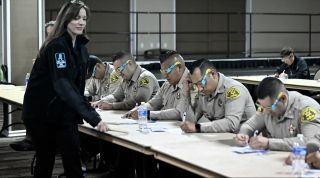Autism
How to Improve Autistic Encounters with Law Enforcement
An expert helps officers better understand the neurodivergent population.
Posted May 16, 2024 Reviewed by Gary Drevitch
Key points
- Autistic people are seven times more likely to encounter police.
- Autistic traits may look suspicious to an untrained law-enforcement officer.
- Officers need to slow down, learn to identify autism, and de-escalate to prevent tragic outcomes.

Few things are more terrifying than a misunderstanding with law enforcement. People of color in America know this all too well. And with the increasing identification of autistic individuals, it is inevitable for police officers to encounter autistic people in their communities. In fact, autistic individuals are seven times more likely to encounter police (Lartey, 2024). About 20 percent will be stopped and questioned, and 5 percent will be arrested by age 21 (Rava, 2016).
I joined a group of Los Angeles County sheriffs, members of the largest sheriff's department in the United States, for a two-hour training by Kate Movius, founder of Autism Interaction Solutions. Movius founded her company when her son started eloping at age 3—a common danger for autistic children. He had wandered away and gone through the doggy door of a neighbor’s house while the neighbors were napping. That incident turned out okay, but it was only the first of many—and 50 percent of parents of autistic children say their child has eloped by age 4 (Bastian, 2023). Drowning is the number-one cause of death for children who have eloped, so knowing where water sources exist and checking there first is critical.
Movius keeps her training short and impactful. The first hour provides psychoeducation about common autistic traits and advice on how to engage with autistic people, physically modeling instructions and offering them alternative methods of communication like a phone or whiteboard to write. She quickly gets the officers involved in interactive sensory and communication exercises, in which she simulates conditions of sensory overwhelm where an autistic person may have difficulty responding. In the second hour, families with autistic young adults join the training and share their lived experience. The young adults I met spoke enthusiastically about their current interests and created pop-culture trivia questions for the officers to answer. On occasion, the presenters have had meltdowns, which, while distressing, are also incredibly instructive for the officers to witness.

What makes interactions with law enforcement so potentially dangerous for the autistic population is that some autistic behaviors look suspicious or even defiant. Not answering questions, looking away, stimming, or echolalia (repeating words back) may draw attention and potentially trigger an officer trained to dominate and control a situation. The sensory storm of loud sirens, lights, and authoritative behavior can agitate autistic people and increase their dysregulation. Autistic people may also have difficulty understanding verbal directions and thus may not be able to execute instructions.
One mother in the training shared the story of her son being pulled over by police while his caregiver was driving. Her son kept looking back at the officers, and they approached his side of the car. They instructed him to put his hands on the dashboard, which he eventually did while screaming back at them that he hadn't done anything wrong. His caregiver was able to share that he was autistic, but the situation could have escalated.

Movius's advice to parents for keeping their children safe is, first and foremost, to communicate with their local police department. Parents can call the police department's non-emergency number and, if possible, arrange a visit with their child to the station. If this isn't feasible, parents can use a "social story" with photos to explain how to interact with police. Families should let their local police department know that someone with autism lives at their address. Many departments have a voluntary registry program, which will flag the address for 911 dispatchers. In the event of a call for service, dispatch would convey this crucial information to responding officers.
Movius states, “It’s frightening to have to interact when you’re under pressure and in crisis. You go into a fight or flight. Even those who are college-educated can become nonverbal in a moment of stress, and when you’re dealing with law enforcement, the stakes couldn’t be higher.”
The most significant takeaway for Movius in her training is for the officers to “slow way down,” which she recognizes is not always possible. The second thing is to “wait for a response far longer than feels comfortable.” She informs her trainees to always keep in the back of their minds that this person could have a developmental disability and their behavior could be involuntary.
Movius, whose son is now 23, has window clings on her car that say, “Autistic occupant. May not respond to commands.” These are available from the National Autism Association. “If I get in an accident and am incapacitated, they’ll be able to understand why there’s a man in the back of my car not responding to them," she says.
Movius's workshop has become part of the department's ongoing mental-health training. With the support of Mayor Cory Moss of the City of Industry, whose own son is autistic, they have assembled sensory toolkits for officers to carry in their patrol cars to soothe an autistic person in distress.
Movius is also on the Board of The L.A. Found Taskforce, a county resource that provides wearable tracking devices, including a Project Lifesaver wristband. Anyone can enroll a loved one who is at risk for wandering, whether autistic or with dementia, and it works in conjunction with law enforcement. The police can track lost persons by air and patrol cars, and they so far have a 100-percent success rate.
Blue Envelope is a program one can request from one's local police station. Autistic drivers keep an envelope in their glove compartment containing their license, registration, and insurance that reads, “Driver is on the autism spectrum” and has information about their diagnosis and triggers.
There is also a registry called If I Need Help that makes tags with QR codes one can attach to a loved one’s clothing or bag if they go missing.
Movius’s mission is to ensure that all of our children can minimize the risk in encounters with police. Autism education for law enforcement officers helps them better identify autistic individuals and de-escalate volatile situations, averting potentially tragic encounters between this vulnerable population and the people in charge of protecting them.
References
Lartey, Jamiles. (2024, March 16). When Police Encounters with Autistic People Turn Fatal. The Marshall Project Closing Argument Newsletter.
Rava, J., Shattuck, P., Rast, J. et al. The Prevalence and Correlates of Involvement in the Criminal Justice System Among Youth on the Autism Spectrum. J Autism Dev Disord 47, 340–346 (2017). https://doi.org/10.1007/s10803-016-2958-3
Bastian, Casey J. (2023, December 15). Dangerous Encounters: Interactions Between Autistic Individuals and Law Enforcement. Criminal Legal News.




